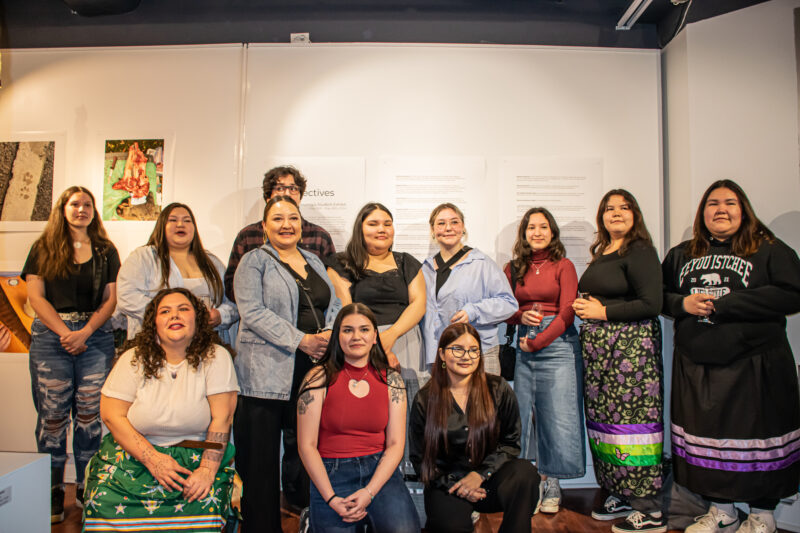Indigenous students reflect on their work exhibited at Dawson’s gallery
Indigenous students at Dawson celebrated a year of land-based learning at a vernissage of their artwork and projects on May 10 at the Warren G. Flowers Art Gallery.
The work was created in the Learning Perspectives course of the Journeys program co-taught by Amanda Lickers and Jocelyn Parr over the last academic year of 2023-2024.
Student Zye Rashontiiostha Mayo said there were two goals for the exhibit: “sharing our artwork and sharing our voices.”
Opportunity to focus on our own culture
Zye, who is Kanienʼkehá꞉ka of the Snipe Clan from Kahnawake, appreciated the opportunity “to focus back on our culture before moving forward in our education.”
Zye had three pieces in the exhibit: fish skin leather, a print and a photo. “I spent a week learning how to make fish skin leather, which is really strong. You can make pouches and wallets and other things from it. I never thought I would come to Dawson and learn about making fish skin leather. I came home and taught my traditional cousin how to make it!”
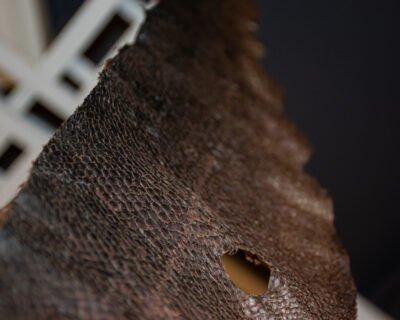
Fish skin leather
His photograph was taken during a grad-year trip with Kahnawake Survival School to upstate New York. Zye entitled it “Looking home.” He explained that his people are known as the “Keepers of the Eastern Door.” The photo was looking east from somewhere along the way between Niagara Falls and Toronto. In the background, you can see forests and Zye is happy there are still forests.
Completing the course and Journeys is a big achievement for Zye. “I am probably the only first-year student from Kahnawake who is still here,” he said. “It was a hard year for people in my community. A lot of people struggle in the CEGEP environment. The First Peoples’ Centre really helped me. It is a place like home- they even play Kahnawake radio!” Zye will begin the Social Change and Solidarity profile in the Social Science program this fall.
A classmate of Zye’s is Tapisa Tulugak, an Inuk from Puvirnituq in Nunavik (a greater distance from Montreal than Halifax). Tapisa had two pieces in the exhibit, which was named Living Perspectives.
It was the first time that she took a course that includes sketching and linocut printmaking. “I am very surprised that I could sketch,” she said.
Healing through art
Tapisa found the course healing and likes Dawson because “they understand Inuit students and there are very open-minded employees.”
Tapisa had a poem and a linocut in the exhibit. She told the story of her poem: “I wrote a poem in Inuktitut when I was a student at Nunavik Sivunitsavut, and it was translated by Jennifer Savard when she was my teacher at Kiuna College back in 2019. We, as Inuit, have been stepped on by the colonizers for too long and it has affected us in so many ways. The Federal Government did so many bad things to Indigenous people all over Canada on our own land and the truth needs to be known for what they did to the Inuit; but we are still standing.”
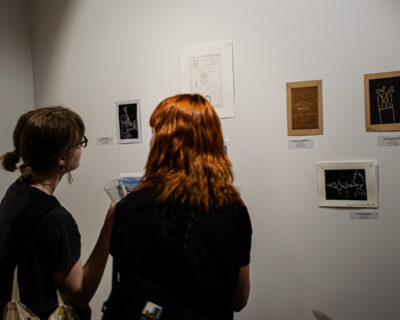
Tapisa really appreciated the course: “I learned that I could stand and be able to have my own art show in the future without any fear. Amanda Lickers, our teacher, brought guests that are inspiring, and I am very grateful for the wonderful experiences.”
Tapisa comes from a line of well-known artists on her father’s side of the family: “My biological father, Peter Boy Ittukallak, is a well-known sculptor and I want to be just like him. I believe Dawson College will open the doors for me to become an artist.”
Messages in the art
Jade Whitebean was in the previous year’s class and she had two pieces in the exhibit. Jade, a Kanienʼkehá꞉ka artist rooted from Akwesasne based on the south shore of Montreal, is now finishing her first year in the Interactive Media Arts profile of the Arts, Literature and Communication program.
Jade’s pieces were both digital illustrations that she worked on using a drawing tablet. She told us about them in an interview:
“The black and white artwork, the older of the two, is titled “Silenced” and was supposed to be a more in-your-face piece and to make more of a statement than anything. The self-portrait, which I titled “Red Echoes” is much more subtle in its meaning however, though it’s still meant to catch your attention.
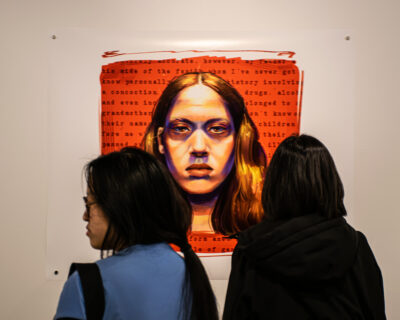
Red Echoes by Jade Whitebean
“ “Red Echoes” was more than just a self-portrait. My most recent piece was meant to reflect generational trauma, which is unfortunately quite common in Indigenous families, mine included. I chose a vibrant red for the background to represent that bond; red is blood, and blood is, well, your family–your lifeline. Your family leaves a mark on you, and you become a part of an echo through generations of those before you, which is what led me to choose that title.
“The words in the back are part of a paragraph I wrote specifically for this piece. Looking closer, you could pick apart some words from the text, and form a bit of a story and an understanding that this artwork is meant to reflect that trauma. The text is behind me as is my past, but it still plays a big part in my life; I’m sort of enclosed in this box that I was born in. …There’s a lot more to see and understand.
“The older piece, “Silenced”, the work that depicts the woman whose mouth is being sewn shut, was actually a piece I did as an assignment in Journeys. …The idea was to express the lack of attention surrounding murdered & missing Indigenous woman. I was inspired by the red hand over the mouth symbol and did something similar by having the mouth sown instead to show how voices are controlled and taken away. Cast off to the side, there’s also a missing person’s poster that is covered by other flyers– it’s to show where the media’s attention really stays while everything else is brushed off.”
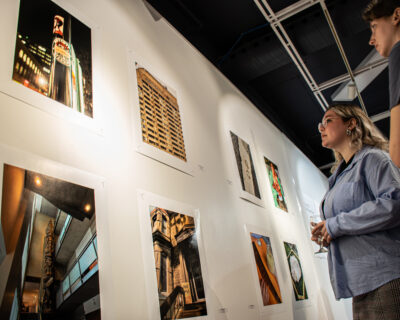
Love for Learning Perspectives
Jade appreciated the opportunities that Amanda and Jocelyn gave students in Learning Perspectives: “I really enjoyed having a small class where you really got to know the teachers and the students around you. … In Learning Perspectives and other Journeys classes, it wasn’t just about getting courses over with, it was really learning and building connections, and I really miss that.”
In Learning Perspectives, students experienced a collaborative learning environment, a decolonized pedagogy and explored Indigenous ways of knowing and learning, such as talking circles, beading workshops, Indigenous governance systems.
“For my part, I think the show was a powerful illustration of what can happen in a decolonial pedagogical environment,” said Jocelyn Parr, who co-taught the course with Amanda Lickers.
“That the learning perspectives course was taught using land-based and strength-based pedagogies meant that the students were encouraged to bring their unique gifts and abilities into the classroom. The college is an educational space that is almost thoroughly saturated with settler values of what constitutes learning. These are values that align with capitalism in that “successful” settler learning means success in a competitive, individualistic, stressful environment where the standards are set by an authority figure with power over you. Learning Perspectives was the opposite of that, and this show—Living Perspectives—allowed students to see themselves as flourishing and powerful in a collaborative and creative environment that was led by the wonderful Amanda, and supported by me.”
All three students expressed much gratitude for the course and their teachers.
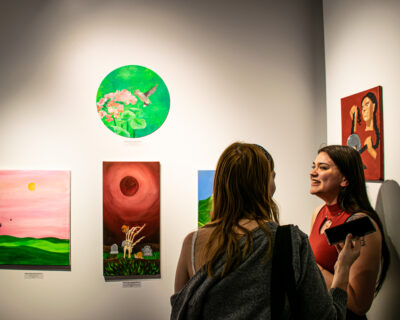
All photos in this story are by Jonathan Givon.
Living Perspectives was in the news:
CBC 6 PM news:https://www.cbc.ca/player/play/video/9.4224097
CBC North with Vanna Blacksmith:https://www.cbc.ca/news/canada/north/dawson-college-indigenous-art-exhibit-living-perspectives-1.7203073
Cree-language interviews featuring Shirleyann Rabbitskin, Phylicia Benjamin, Melissa Matoush and Stacey Matoush: https://www.cbc.ca/listen/live-radio/1-146-winschgaoug-cree?fbclid=IwZXh0bgNhZW0CMTAAAR3h0BZQvkv-_X4Abi-KJlcCrkTWtlk8FuLVqQ8Sc3Oa0x4FxT_2C61tHZs_aem_AYIEhVbp357QVEW8S1YF9lUjlnvVU2PbC7Ips85pLDv_ngB70-mhxFhnygILXQR8bZJityFSw9Tt-M81j3bZ70qd

